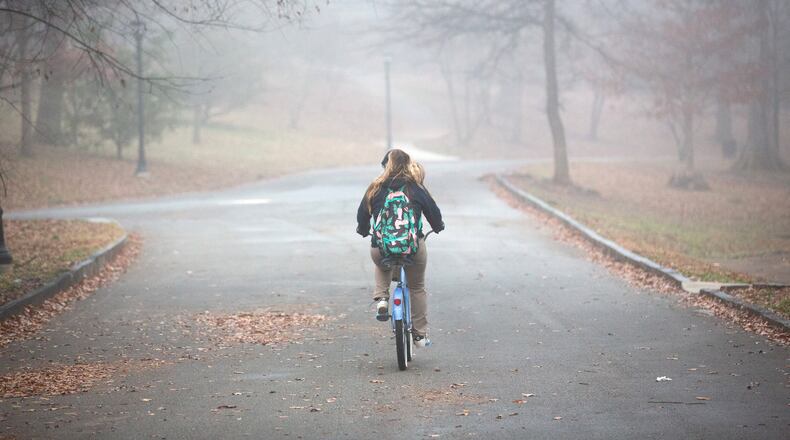Stephen Spring is a longtime advocate for public education and public transportation. An avid biker, he says Atlanta’s decision to start high school early to accommodate the bus schedule could be avoided if students were encouraged to travel to school by MARTA or bikes.
Spring taught high school mathematics for nearly two decades, served as the policy chair on the Portland, Maine, school board, earned a master’s in education leadership and completed the coursework in an education policy doctoral program.
Like the 16-year-old exemplified in this narrative, the 57-year-old Spring negotiates Atlanta on foot, on bike, on a scooter, and relies on connecting to MARTA for essential trips.
By Stephen Spring
As school districts across these United States shift to later start times for high schools, Atlanta Public Schools mandates earlier start times. Research is clear on this — academic performance for teenagers improves with later school start times.
On the Centers for Disease Control and Prevention’s Healthy Schools website, decision-makers are provided tons of research and very clear guidance:
Students should get the proper amount of sleep at night to help stay focused, improve concentration, and improve academic performance. School districts can support adequate sleep among students by implementing delayed school start times.
I posit that all policies at the school district level must be inspected through the lens of student outcomes. Those that do damage to our youth are rejected. Excising harmful practices and policies from our schools is required action if we are to create space for Atlantans to engage in rigorous problem-solving.
Why did the Atlanta public school system enact a policy that results in less learning for high school students? The reason stated, “operations,” which, from my experience serving on another city’s school board, translates into transportation — yellow school buses.
To elevate student learning in earlier grades, the school day for our youngest in Atlanta was increased by 30 minutes, creating a dilemma for yellow school buses. They cannot be in two places at once.
The non-solution: Disregard learning theorists and wake up adolescents earlier. This policy move takes learning away from one group of kids in order to give it to another. Interrupting this bartering practice in our policymaking is the actual dilemma here.
I reject positioning student learning like it is a tradeable, finite commodity. Atlanta, we know how to, and we must do better. I offer a viable solution that has been put into practice in cities across the United States.
Back when I was on the Portland School Board, we were successful in enacting policy so that all middle and high school students could use public transportation 24/7/365 at no cost. This was an essential city-school system collaborative move for Portland to liberate decision-makers from the constraints of “operations” when trying to do the right thing.
Yellow school bus scheduling was no longer going to take priority over scheduling a child’s education. Engaged community dialogue schooled we elected officials on these additional tangible benefits of our youth access to transit policy:
Frees parents up from having to taxi their kids all over town.
Reallocates the costs of yellow school buses for older youth to critical areas of teaching and learning.
Expands employment opportunities for youth.
Widens young peoples' social geography.
Creates lifelong users of sustainable transportation.
Increases physical activity.
What might it look like if we empowered a resilient high school student with mobility in Atlanta? It is Thursday. A 16-year-old high school student wakes up at 7:15 a.m., knowing how to get to school. She has lived in Atlanta her whole life. In fact, she is two years away from being a member of the third generation of her family to graduate from Atlanta Public Schools.
The MARTA bus stop is a half mile away, and she has the schedule downloaded. The walk and ride are actually less time-consuming than when she took the yellow school bus last year. Today, she chooses to ride a bike to the bus stop, saving 10 minutes. MARTA buses and trains are cool with bringing bikes and skateboards and scooters on board, so the student simply brings her wheels with her. This is perfect because Thursdays after school she has to take the train to work. The optimal station to get her to the job is a mile from the school, so she will bike that rather than wait for the bus. She has got the after-work train-bus schedule programmed on her app to get home at night.
And, when she gets back home, she can sleep a full eight hours, knowing how to get herself to her first class at 8:55 Friday morning. She is independent; she is resilient; she is empowered.
This 16-year-old is living in and negotiating Atlanta in a way that was recently captured by Jeezy in Atlanta when he was talking about the deeper meaning of youth mobility:
The only time I felt free was when I was in motion. That is your chance to see where you want to go in life because if you stay still, that is where you will stay. If you have got a vision, you can achieve it, just like you can ride from one street to the next, you can do that with life, too!
While Atlanta sleeps, our children fall behind, our public transportation system goes underused, our youths’ options are limited, and our unsolved dilemmas become acceptable ways of being.
We know better. Atlanta is a city packed with skilled, creative, and resilient people. We’ve got visions and we can achieve them. Our vibrant youth need eight hours to reset their brains to be high functioning the next day.
About the Author
The Latest
Featured



